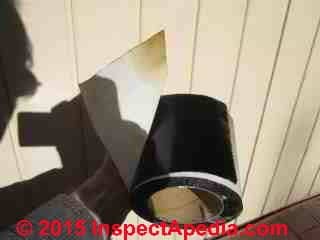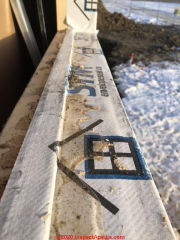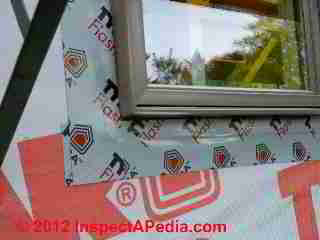 Peel & Stick Flashing Tape FAQs
Peel & Stick Flashing Tape FAQs
Questions & answers on how to use self-adhesive flashing tape
- POST a QUESTION or COMMENT about how to buy & apply peel and stick flashing tape around window & doors or at housewrap joints or holes.
Peel and stick flashing tape or membrane questions & answers:
Frequently-asked questions and answers about how to buy, install & detail stick-on flashing tape around windows & doors.
This article series describes the selection and installation of peel-and-stick flashing membranes used on building exteriors to seal housewrap joints and to seal against air or water leaks around windows, doors, or other openings. Our photo at page top shows Typar® flashing tape installed above a new window. A better practice laps the housewrap over rather than under the stick-on flashing tape, a better detail but one omitted by many builders.
InspectAPedia tolerates no conflicts of interest. We have no relationship with advertisers, products, or services discussed at this website.
Using Building Flashing Membranes - Peel & Stick Flashing Tape
 These questions & answers about flashing membranes and tapes were posted originally at FLASHING MEMBRANES PEEL & STICK - please be sure to see the advice given there.
These questions & answers about flashing membranes and tapes were posted originally at FLASHING MEMBRANES PEEL & STICK - please be sure to see the advice given there.
On 2020-10-21 - by (mod) -
Maybe a photo of the situation would permit more comment?
On 2020-10-21 by Terry
Thanks! That's very helpful.
On 2020-10-21 - by (mod) -
Terry
That's an interesting idea - an effort to seal between the upper surface of the brick and the under-side of the treated wood; I would watch for a couple of snafus:
1. if the treated wood is as often bought from the lumber yard its surface may be wet and even dirty enough that your peel and stick flashing may not bond well
2. any future defect or separation between the stick-on flashing (now sitting sticky-side "up" which is not how it was intended to be used) may trap water and speed the decay of the treated wood.
3. painting on a sealer won't work if the wood is not fully dry - the adhesion of that will fail too
My preferred design would be to design the lattice fence bottom to permit drainage and to permit the wood to dry by using spacers to keep most of the wood from direct contact with the flat, sometimes wet, masonry surface.
On 2020-10-21 by Terry
I'm rebuilding a wood lattice fence that sits ontop of a brick wall. Pressure treated 2x4's will lie directly on top of the flat brick wall. The previous fence lasted about 25 years, but at the end the 2x4s understandably suffered from rot and decay. Everyone says to seal the wood, which I'll do of course, but I've always wondered it it would make sense to also apply a peel-and-stick flashing tape to the underside of the 2x4. Would this be advisable or are there reasons not to do this? Thanks!
On 2020-09-19 1 - by (mod) -
Carol I'm not clear on what we're discussing: posts or beams; Posts are vertical supports;
Metal saddle? Flashing? Perhaps you can post a photo. One per comment.
On 2020-09-19 by Carol R
We have a relatively new home and several large cedar beams on our front porch and back. When installed, they did not use any type of metal saddle to help the beams not absorb water when it rains. Can flashing tape be used around the base to help this problem.?
On 2020-03-19 - by (mod) -
Richard
Indeed it's important to distinguish between peel-and-stick flashing membranes used on building exteriors and shower pan liners and membranes as they are different products with different requirements.
If you have an application that needs to hold standing water I'd recommend either using EPDM (rubber roofing) outdoors, or if protected by a finish surface, a shower pan liner rated for that use.
Please see details at
inspectapedia.com/BestPractices/Bath_Shower_Pan_Installation.php SHOWER PAN INSTALLATION & LINERS
where we'll repeat your question and our reply to invite comment from other readers.
On 2020-03-19 by Richard McLauchlan
Shocked to discover many peal stick membranes (none torch on) are not designed warrantied to hold standing water! sill pan protection not
On 2020-02-04 - by (mod) -
 Richard
Richard
Thank you for the important comment and photo.
Now near the end of FLASHING MEMBRANES PEEL & STICK you'll find your photo and our discussion - there I offer a more-detailed reply.
On 2020-02-04 by Richard
Interesting and educational piece. Our efforts in this area have discoverer most all peal and stick membranes are not designed nor warranties to hold standing water. Standing water such as a window will pan flashing.
Question: "blue skin" for trailer roofs
(May 11, 2014) alex said:
can you put blue skin on a travel trailer roof and paint over with rubber paint
Reply:
Alex I'm not sure what the blue skin product is (name and product name would allow some research. But certainly there are a number of roof-over materials for leaky trailer roofs, including rubber coatings. Without a membrane these may not be a lasting repair.
What I would not try is simply rolling out a self-adhering flashing membrane on your trailer's roof - don't use a product that was not designed to be left exposed to the weather. It won't endure.
Question: flashing membranes adherence to old masonry chimneys
(July 28, 2014) Jean said:
Can peel and stick flashing membranes be used on masonry (old chimney) or only on wood decking?
Reply:
Jean,
Some of the flashing membrane product lines listed above such as FortiFlash® include products designed to adhere to cleand dry masonry.
Unfortuntately, too-often I have not seen good adhesion of a peel-and-stick flashing membrane along a masonry surface such as an older, rough-surfaced masonry brick or block chimney. And these membranes are not intended to be left exposed to the weather. Further, even if it adhered, you'd need counterflashing over the upper edge of the membrane to assure a durable installation.
Question: peel-and-stick membranes in roof valleys
(Aug 12, 2014) Donald said:
Can peal and stick membranes be used on steel roof valleys?
Reply:
Donald, the flashing tapes we describe here are expected to be covered by a finish material. These membranes do add valuable leak-insurance used beneath a finsish-material placed in a roof valley.
Question: will flashing tapes seal around a screw
(Aug 31, 2014) Gary said:
Will Flashing Tapes and membranes self seal around a screw, particularly the screw that holds the exterior finish (i.e. Siding) on to the substrate?
Reply:
Gary
Great question. My answer is yes ... and sometimes no.
Peel-and-stick membranes are intended to seal around small-diameter penetrants such as staples and roofing nails. Where I've seen leaks through a P&S membrane on a roof they were traced to a mis-hammered roofing nail that folded over and whose head made a significant cut in the membrane.
I've also come across a few tears in flashing membranes that were subjected to twisting forces from a screw as it penetrated the material, in particular if the flashing material was not itself thoroughly bonded to the substrate surface.
Where I've seen leaks over doors and windows that were traced to flashing tape troubles the issue was either failure of the tape to bond to an older weathered surface or to someone having driven a 16d nail through the material.
And of course no flashing tape on a building wall, say over a window, is going to be able to prevent leaks that run down behind the housewrap from some leak point higher on the building.
Question: Blueskin SA compatable for a tie-in with a 2-ply hot asphalt vapour retarder
(Sept 3, 2014) Leo said:
Is Blueskin SA compatable for a tie-in with a 2-ply hot asphalt vapour retarder on a flat roof transition?
Reply:
Blueskin SA is an SBS-modified self-adhering membrane made of SBS rubberized asphalt compound that has been laminated onto a blue polyethylene reinforcing film.
Blueskin is produced by the Henry Company, 999 North Sepulveda Blvd., Suite 800 El Segundo, CA 90245 310-955-9200. Contact the company at E-mail: productsupport@henry.com Phone: 800-486-1278
The material is designed to bond or "stick to" prepared concrete, concrete block, primed steeol, mill-finished aluminum (remove any oils), anodized aluminum, galvanized metal, gypsum board and plywood.
The material (as well as others of this type) is not designed to bond to a hot asphalt-sealed surface.
Question:
(Oct 7, 2014) Anonymous said:
We will be pouring a large 70' patio with stamped concrete. What type of flashing should be used when connecting new concrete landings to the house wood frame support? The landings are both 12" wide where they connect to the house and will allow entry into two 8 foot wide doorwalls.
Reply:
Please take a look at DECK FLASHING
Question: how to remove flashing membranes from concrete
11/06/2014 Steve said:
I bet this isn't asked often. Once you apply Fortiflash to concrete, how do you get the stuff off. We removed an old shed that was sealed to the concrete driveway with this stuff, and outside of grinding it off, we haven't had any luck.
Reply:
Steve,
Removing a well-adhered flashing membrane such as FortiFlash can be difficult on any surface. At least on concrete you could heat it gently to try peeling it off but I'd bet that the result will leave black residue on the concrete surface.
For other readers, FortiFlash(R) is a waterproof flashing membrane produced by Fortifiber Building Systems Group (R), a Fernley NV USA company. The product is a self-adhesive membrane reinforced by high-density polyethylene film that the manufacturer also refers to as “rubberized asphalt” and is described more technically as “a self-sealing SBS modified asphalt core laminated to a cross-laminated high-density polyethylene film reinforcement with a siliconized paper release sheet.”
It’s possible that the installer used Fortiflash 40(r) for floors - a vapor retarder system that can be adhered to concrete. It looks as if the composition of that product is similar.
As such if you can physically peel off the reinforced sheet you might use an organic solvent on the remaining modified asphalt adhesive. The company’s literature points out that the product is not compatible with EPDM (Rubber roofing), flexible PVC products and some sealants - but I don’t find much help from those products when considering how to remove FortiFlash membranes.
My best advice would is to contact the company directly for advice on the safest and most effective solvent to use.
Contact Fortifiber Building Systems at
1-800-773-4777 for sales and technical assistance. Website: www.fortifiber.com
Question: how to remove peel and stick flashing tape or membranes
(Nov 6, 2014) Steve said:
I bet this isn't asked often. Once you apply fortiflash to concrete, how do you get the stuff off. We removed an old shed that was sealed to the concrete driveway with this stuff, and outside of grinding it off, we haven't had any luck.
Reply:
Steve,
Removing a well-adhered flashing membrane such as FortiFlash can be difficult on any surface. At least on concrete you could heat it gently to try peeling it off but I'd bet that the result will leave black residue on the concrete surface.
For other readers, FortiFlash(R) is a waterproof flashing membrane produced by Fortifiber Building Systems Group (R), a Fernley NV USA company. The product is a self-adhesive membrane reinforced by high-density polyethylene film that the manufacturer also refers to as “rubberized asphalt” and is described more technically as “a self-sealing SBS modified asphalt core laminated to a cross-laminated high-density polyethylene film reinforcement with a siliconized paper release sheet.”
It’s possible that the installer used Fortiflash 40(r) for floors - a vapor retarder system that can be adhered to concrete. It looks as if the composition of that product is similar.
As such if you can physically peel off the reinforced sheet you might use an organic solvent on the remaining modified asphalt adhesive. The company’s literature points out that the product is not compatible with EPDM (Rubber roofing), flexible PVC products and some sealants - but I don’t find much help from those products when considering how to remove FortiFlash membranes.
My best advice would is to contact the company directly for advice on the safest and most effective solvent to use.
Contact Fortifiber Building Systems at
1-800-773-4777 for sales and technical assistance. Website: www.fortifiber.com
Question: builder left out flashing membrane now I have a leak
(Nov 7, 2014) Steve K. said:
I have an leak that is giving me an immense headache. My builder talked me into creating a storage room under my front porch. Because the porch large exposed to the weather, I instructed him to install a waterproof membrane under the concrete slab and to lap it under the Tyvek membrane on the house's exterior.
He forgot that detail, and I did not discover the mistake until the house was completed. The porch is poured concrete over a metal pan. The exterior structure consisted of OSB (all seams taped), one inch of Dow blue foam (all seams taped), Commercial D housewrap, 1x4 pressure treated strapping, and then cement siding.
When it rains, the most exposed portion of the porch leaks into the storm room, wetting the framing and introducing water into my very tight house. (The builder is MIA at this point.) I looked around for solutions but not found one. Taking off some of the siding, cutting back to the sheathing, and installing some flashing over the OSB and concrete seems like the best option, but I am not knowledgeable enough about building materials to know for sure.
Reply:
Steve
I am not sure I've got the details clearly in mind for the case you describe. Use our CONTACT link found at page top or bottom to send me photos and a sketch if you can and I might make more sense of this leak problem.
I'm a bit worried that flashing that terminates under ground and runs up under building siding risks giving an attractive pathway for termites (if you've got those critters in your area)
And I'm unclear on how the storage room is open to or protected from the weather.
So pending a better understanding I can just offer a very general comment that flashing is expected both to keep water out of a construction intersection of planes and to direct water out onto an exposed surface where it can drain away without causing trouble.
Question:
(July 30, 2015) daren said:
if i was to use this tape in conjunction with liquid rubber, how would the rubber adhere to the tape?
would it be better to rubber the seam and the apply tape...followed by rubber
Reply:
That's not an application I've seen described by the flashing tape manufacturer. I am doubtful that liquid rubber or any other adhesive will bond well to what I think is a super-smooth polyethylene type or mylar type covering left on the exposed side of the flashing tape. It might adhere to a metallic covering used on some tapes.
Question: is it wrong to use flashing tape underneath a window or door
 Pat said:
Pat said:
Can someone please clarify this issue? Most everywhere I've read about window flashing tape, it states to never apply it to the bottom of the window on the outside so water can exit to the house wrap instead of under the house wrap.
My siding crew taped the bottom of the window like shown in this article but I'm less worried about it because there's an open flap of house wrap below the window where water can eventually exit. Also, I insisted on a rain screen and the house wrap should let water escape so it should get stuck inside. Either way, I don't think taping the bottom is hardly ever recommended.
Reply: no but it must be installed before the window or door is set in place.
Pat: You're quite correct. The photo showing peel and stick flashing tape applied over the window bottom flange and onto the building WRP or housewrap is not a recommended detail and might trap water in the window rough opening. Please see complete details at WINDOW & DOOR FLASHING TAPE DETAILS - separate article
What is the best way to flash around windows & doors and how should flashing tape be used at these openings? This article series shows best practices, common practices, and some not-so-good practices using peel-and stick flashing tape around windows, doors, and other building wall penetrations.
...
Continue reading at PEEL & STICK FLASHING MEMBRANES - topic home, or select a topic from the closely-related articles below, or see the complete ARTICLE INDEX.
Or see this
Article Series Contents
- CAULKS & SEALANTS, EXTERIOR
- FLASHING for METAL ROOFS
- PEEL & STICK FLASHING MEMBRANES
- WINDOW & DOOR FLASHING TAPE DETAILS
- WINDOW FLASHING & SEALING Guide
Suggested citation for this web page
FLASHING MEMBRANE FAQs at InspectApedia.com - online encyclopedia of building & environmental inspection, testing, diagnosis, repair, & problem prevention advice.
Or see this
INDEX to RELATED ARTICLES: ARTICLE INDEX to BUILDING FLASHING
Or use the SEARCH BOX found below to Ask a Question or Search InspectApedia
Ask a Question or Search InspectApedia
Try the search box just below, or if you prefer, post a question or comment in the Comments box below and we will respond promptly.
Search the InspectApedia website
Note: appearance of your Comment below may be delayed: if your comment contains an image, photograph, web link, or text that looks to the software as if it might be a web link, your posting will appear after it has been approved by a moderator. Apologies for the delay.
Only one image can be added per comment but you can post as many comments, and therefore images, as you like.
You will not receive a notification when a response to your question has been posted.
Please bookmark this page to make it easy for you to check back for our response.
Our Comment Box is provided by Countable Web Productions countable.ca
Citations & References
In addition to any citations in the article above, a full list is available on request.
- Best Practices Guide to Residential Construction, by Steven Bliss. John Wiley & Sons, 2006. ISBN-10: 0471648361, ISBN-13: 978-0471648369, Hardcover: 320 pages, available from Amazon.com and also Wiley.com. See our book review of this publication.
- Eric Galow, Galow Homes, Lagrangeville, NY. Mr. Galow can be reached by email: ericgalow@gmail.com or by telephone: 914-474-6613. Mr. Galow specializes in residential construction including both new homes and repairs, renovations, and additions.
- Paul Galow [Website galowconsulting.com ] - technical consultant on networking, LAN design, applications support. Galow Consulting Services [Website galowconsulting.com ] , 914-204-1749, email: paulgalow@galowconsulting.com
- John Rudy, Advantage Home Inspections, Flemington N.J. 08822 home inspector, 908-806- 6364, Home, Radon & Termite Inspections, Central & Parts of North New Jersey, email: jonadvantage1@yahoo.com
- Our recommended books about building & mechanical systems design, inspection, problem diagnosis, and repair, and about indoor environment and IAQ testing, diagnosis, and cleanup are at the InspectAPedia Bookstore. Also see our Book Reviews - InspectAPedia.
- Decks and Porches, the JLC Guide to, Best Practices for Outdoor Spaces, Steve Bliss (Editor), The Journal of Light Construction, Williston VT, 2010 ISBN 10: 1-928580-42-4, ISBN 13: 978-1-928580-42-3, available from Amazon.com
- The Journal of Light Construction has generously given reprint permission to InspectAPedia.com for this article. All rights and contents are ©Journal of Light Construction and may not be reproduced in any form.
- In addition to citations & references found in this article, see the research citations given at the end of the related articles found at our suggested
CONTINUE READING or RECOMMENDED ARTICLES.
- Carson, Dunlop & Associates Ltd., 120 Carlton Street Suite 407, Toronto ON M5A 4K2. Tel: (416) 964-9415 1-800-268-7070 Email: info@carsondunlop.com. Alan Carson is a past president of ASHI, the American Society of Home Inspectors.
Thanks to Alan Carson and Bob Dunlop, for permission for InspectAPedia to use text excerpts from The HOME REFERENCE BOOK - the Encyclopedia of Homes and to use illustrations from The ILLUSTRATED HOME .
Carson Dunlop Associates provides extensive home inspection education and report writing material. In gratitude we provide links to tsome Carson Dunlop Associates products and services.

